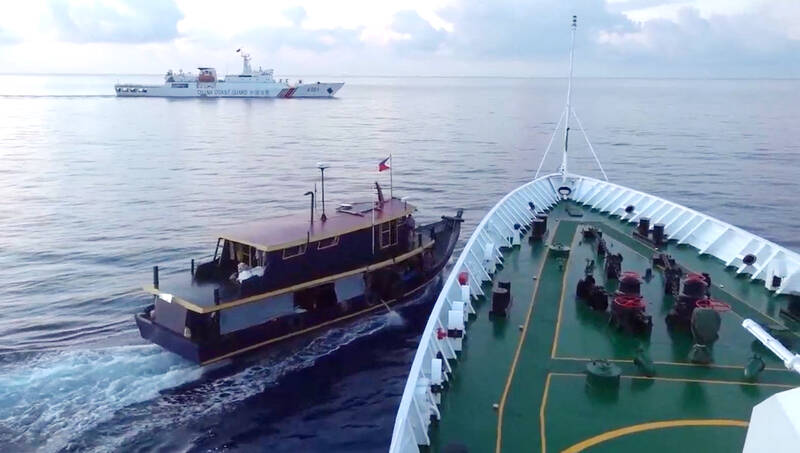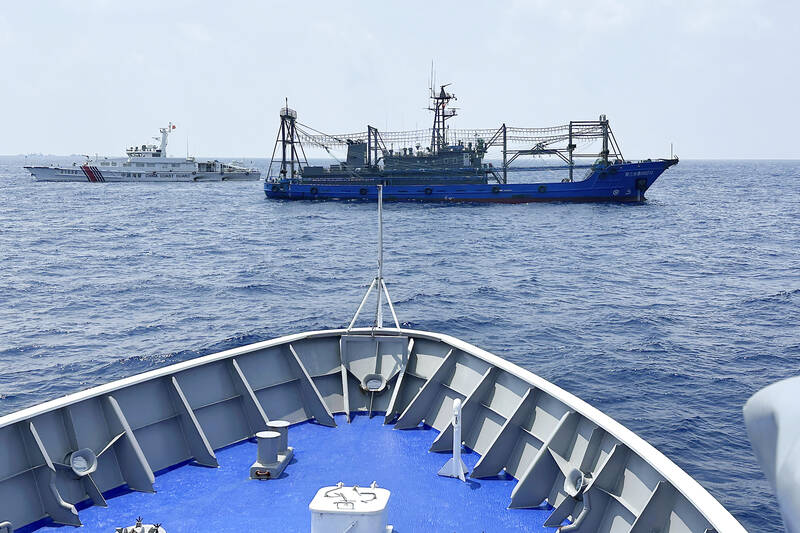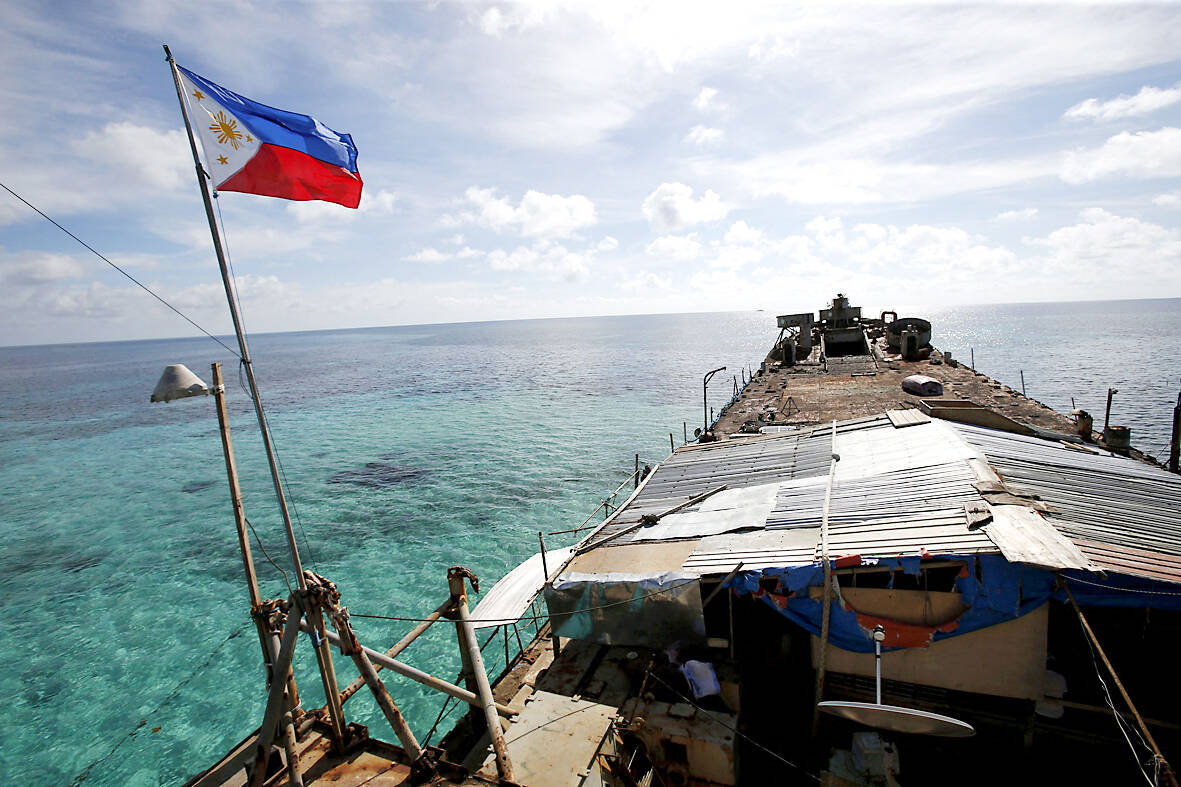It is perhaps the most unlikely kind of military base. For more than two decades, a World War II-era ship, BRP Sierra Madre, has stood deliberately grounded in the remote, shallow waters of the fiercely contested South China Sea, carrying the Philippine flag and guarding against Chinese expansion.
But its future is increasingly precarious, and the ship has become a growing flashpoint in one of the world’s most disputed waters.
The Sierra Madre, marooned on Second Thomas Shoal, in the Spratly Islands, since 1999, is effectively a shipwreck. Rust has ravaged its sides and holes pierce its shell. Defense experts question how much longer it can last — and the Philippines faces a difficult decision about what to do next. So too might the US, which has a mutual defense treaty with Manila, and considers the South China Sea, one of the world’s busiest shipping routes, strategically important.

Photo: AFP
Attempts by the Philippines to deliver supplies to a handful of marines living on the ship have been repeatedly blocked by China, which has demanded the ship’s removal. Analysts say Beijing is effectively waiting for the ship to crumble, leaving the shoal unoccupied. On Sunday, Philippine and Chinese vessels collided twice as Manila attempted a resupply mission, the latest in a series of tense maritime confrontations.
Abandoning the ship would mark a difficult retreat for the Philippines. The Sierra Madre is “a symbol of how far and by how much our sovereignty and sovereign rights stretch,” says Jaime Naval, assistant professor at University of the Philippines.
Bringing construction materials, even to partially repair the Sierra Madre, is logistically complex — whether by air or water.

Photo: AP
“Getting something through unmolested by sea is almost impossible unless you did something that was low-observable but there’s nothing in the Philippines inventory that has the speed or the stealth to get through all of that,” says Raymond Powell, a fellow at Stanford University’s Gordian Knot Center for National Security Innovation in the US.
Second Thomas Shoal has only one, very narrow entrance, which can easily be blocked, and Chinese ships can be quickly deployed from nearby Mischief Reef, which has been occupied by China since 1995, says Powell.
“Mischief reef is really in some ways the perfect weapon for a blockade,” he adds.

Photo: Reuters
It was China’s seizure of Mischief Reef in 1995 that prompted Manila to run the Sierra Madre aground at Second Thomas Shoal. Both locations are less than 200 nautical miles from the coast of the Philippine island Palawan, and so are part of the country’s exclusive economic zone — meaning the Philippines has the right to exploit resources and construct in the area.
After the recent collisions, which the Philippines blamed on China’s “dangerous, irresponsible and illegal” behavior blocking its boats, China’s foreign ministry spokesperson Mao Ning (毛寧) said the Chinese coast guard had “lawfully” blocked Philippine attempts to send construction materials” to the ship, which it claimed had been illegally grounded.
Beijing claims almost all of the South China Sea — despite a UN tribunal finding this has no legal basis.
Collisions between Chinese and Philippine vessels last week are just the latest confrontation during a resupply mission. In August, Chinese coast guard vessels used water cannon against a similar Philippine resupply boat. In February Manila accused China of directing a military-grade laser at a Philippine vessel.
Analysts have warned that confrontations are becoming more intense, and frequent, and that there is an increasing risk of miscalculation in what is a long running and delicate dispute. The mutual defense treaty between Manila and Washington extends to armed attacks on Philippine armed forces, public vessels and aircraft — including those of its Coast Guard — anywhere in the South China Sea, the US state department has said. Were the situation to escalate, this could bring the US into confrontation with Beijing.
Tensions have risen to a level not been seen since 2014, when the Philippines airdropped food and water to Second Thomas Shoal to overcome a China-imposed blockade, said Harrison Pretat, associate director and associate fellow, of the Asia Maritime Transparency Initiative at The Center for Strategic and International Studies, a Washington-based thinktank.
Some have questioned if an airdrop could be used again to deliver supplies, but analysts say it is not a sustainable option. The Manila-based think tank Stratbase ADR Institute this week called for Manila to consider joint patrols with the US and other partners, with its president Dindo Manhit saying, “Only by working together can the Philippines successfully assert its right.”
Joint patrols, too, would raise difficult questions, said Pretat.
“If a US ship starts to accompany the resupply missions, are they going to continue to accompany them for every resupply mission in the future?” says Pretat, who added that such missions happen once or even twice a month.
It’s also unclear what a joint patrol would look like in practice, and these could risk further heightening tensions.
Patrols with partner countries other than the US could help tackle Beijing’s narrative that Washington is using the Philippines to stir trouble in the region, says Naval.
“The Chinese are trying to oversimplify the narrative [suggesting that] it’s just a battle between two big elephants. It’s not.”
Under president Ferdinand Marcos Jr, the Philippines has revived its alliance with the US, which had soured under his predecessor Rodrigo Duterte, but it has also strengthened ties with Japan and Australia.
Last week, General Romeo Brawner, chief of staff of the armed forces of the Philippines, said that it had begun superficial repairs on the ship.
It was sad to see the state of the living conditions where the small contingent of troops were staying, he said.
“We’re trying to improve that by making sure they have at least decent sleeping facilities, decent dining facilities, Internet,” Brawner said.
Naval has, in the past, interviewed soldiers who were deployed to the ship.
“Simply put, it makes you mad,” he says. Soldiers stay in small quarters, “eyeball to eyeball with everyone,” for months, he says.
Storms are severe and there is little comfort, other than a battery-powered TV playing the same movies on repeat.
Given the dilapidated state of the Sierra Madre, it’s unclear to what extent it can be salvaged, says Powell, who added that abandoning the ship, and surprising Beijing by running another vessel aground at a nearby shoal, could be an alternative option. Troops could be moved over to a new ship at an atoll nearer to the coast of Palawan, such as Sabina Shoal, he adds.
“It would be a defeat of sorts, but at the same time it would be a victory of sorts because they’d get to start afresh,” he says, adding that materials for long-term maintenance could be brought on board.
If the atoll were left unoccupied, it’s not clear whether China would seek to build on it, given that Mischief Reef is about 30km away, says Pretat.
Nobody knows how long the Sierra Madre has left before it succumbs to the elements, but Powell says there are concerns its collapse could come within months, not years.
“We have to be ready for the idea it could start tomorrow.”

June 9 to June 15 A photo of two men riding trendy high-wheel Penny-Farthing bicycles past a Qing Dynasty gate aptly captures the essence of Taipei in 1897 — a newly colonized city on the cusp of great change. The Japanese began making significant modifications to the cityscape in 1899, tearing down Qing-era structures, widening boulevards and installing Western-style infrastructure and buildings. The photographer, Minosuke Imamura, only spent a year in Taiwan as a cartographer for the governor-general’s office, but he left behind a treasure trove of 130 images showing life at the onset of Japanese rule, spanning July 1897 to

In an interview posted online by United Daily News (UDN) on May 26, current Chinese Nationalist Party (KMT) Chairman Eric Chu (朱立倫) was asked about Taichung Mayor Lu Shiow-yen (盧秀燕) replacing him as party chair. Though not yet officially running, by the customs of Taiwan politics, Lu has been signalling she is both running for party chair and to be the party’s 2028 presidential candidate. She told an international media outlet that she was considering a run. She also gave a speech in Keelung on national priorities and foreign affairs. For details, see the May 23 edition of this column,

The Taiwan People’s Party (TPP) on May 18 held a rally in Taichung to mark the anniversary of President William Lai’s (賴清德) inauguration on May 20. The title of the rally could be loosely translated to “May 18 recall fraudulent goods” (518退貨ㄌㄨㄚˋ!). Unlike in English, where the terms are the same, “recall” (退貨) in this context refers to product recalls due to damaged, defective or fraudulent merchandise, not the political recalls (罷免) currently dominating the headlines. I attended the rally to determine if the impression was correct that the TPP under party Chairman Huang Kuo-Chang (黃國昌) had little of a

At Computex 2025, Nvidia CEO Jensen Huang (黃仁勳) urged the government to subsidize AI. “All schools in Taiwan must integrate AI into their curricula,” he declared. A few months earlier, he said, “If I were a student today, I’d immediately start using tools like ChatGPT, Gemini Pro and Grok to learn, write and accelerate my thinking.” Huang sees the AI-bullet train leaving the station. And as one of its drivers, he’s worried about youth not getting on board — bad for their careers, and bad for his workforce. As a semiconductor supply-chain powerhouse and AI hub wannabe, Taiwan is seeing